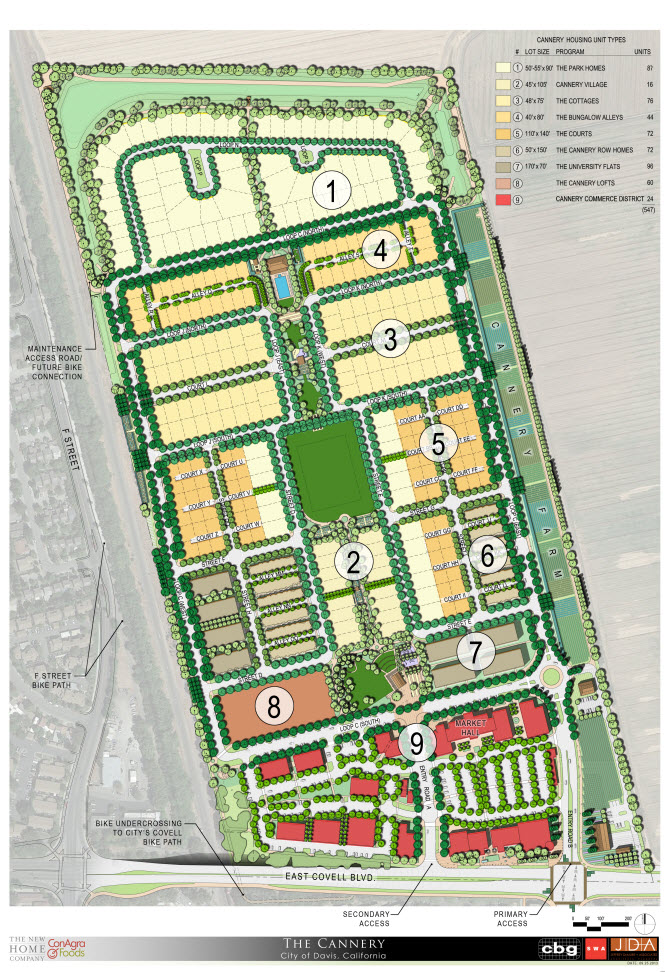 by Matt Williams
by Matt Williams
The first paragraph in last Saturday’s article on the upcoming Tuesday Cannery workshop read, “There will be no decision made on Cannery on Tuesday. According to the staff report, “The purpose of the October 22 workshop is to introduce the project and applications to the City Council and the public. Although many of the materials will be available in advance of the meeting, Councilmembers are not expected to have fully absorbed the materials by the time of the October 22nd workshop.”
. . . no decision about Cannery was made.
However, I’m not sure that the final sentence in that first paragraph was true. As best as I could tell, all five Councilmembers seemed to have no shortage of knowledge about the Cannery. Indeed after Staff finished their relatively brief presentation on the project followed by an incredibly thorough hour plus presentation by the project team from:
- Steve McMurtry of De Novo Planning Group (on CEQA and the EIR),
- Andrea Clark and Jennifer Taylor of the Center for Land-Based Learning (on the Urban Farm),
- Mike McKeever, the Executive Director of SACOG (on Jobs/Housing Balance, the Rural to Urban Connection Strategy, Projected Bicycle Usage and Projecteed Automobile Miles),
- George Phillips the representative of ConAgra, and
- Erin Clay-Scherer, of Eskaton’s Livable Design Division
The Council asked a limited number of very informed questions, none of which broke any new ground.
The project team presentation was so thorough that Mayor Krovoza, in an effort to get to public comment, cut Ms. Clay-Scherer off in her presentation about universal access.
When it actually happened, the public comment was pretty tame. Only eleven (11) people spoke and the general themes of the comment followed a similar pattern to the public comments at the September 25th Planning Commission meeting reported here in the Vanguard. (see article)
The most interesting aspect of the night was the part of George Lewis’ presentation where he showed how the City of Davis grew up to the edge of and around the Cannery over a 60 year period. I provide George’s graphics here without commentary. I’m sure the readers of this article will have lots of their own comments to share about the story these graphics tell.
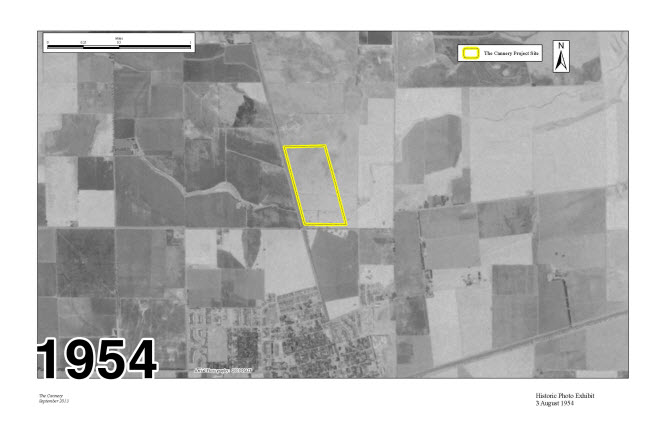
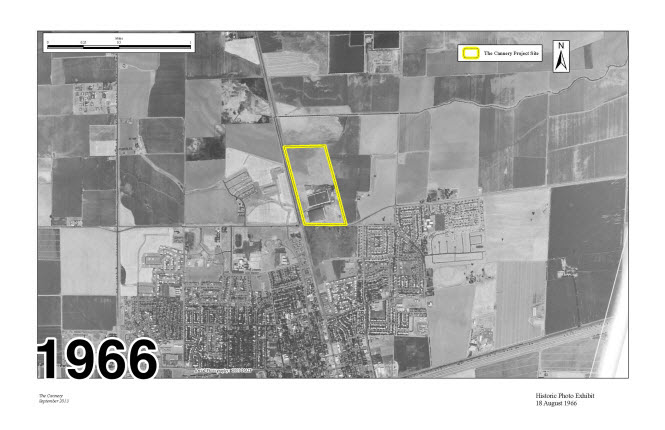
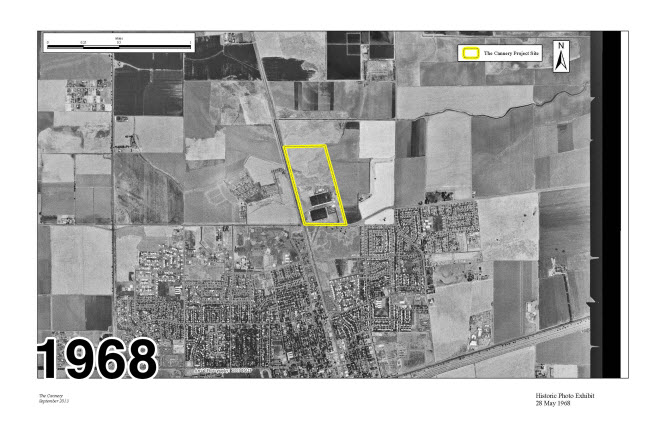
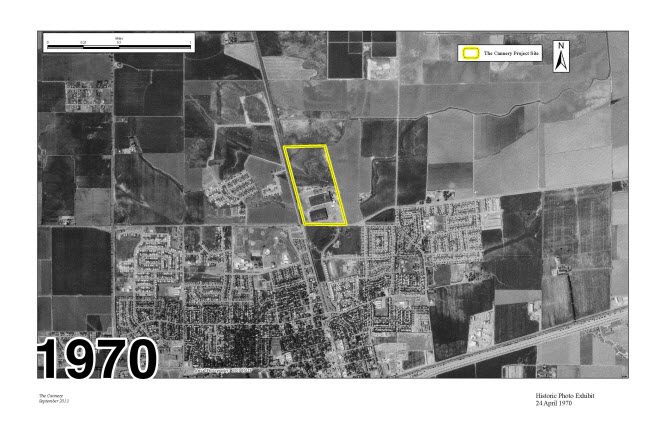
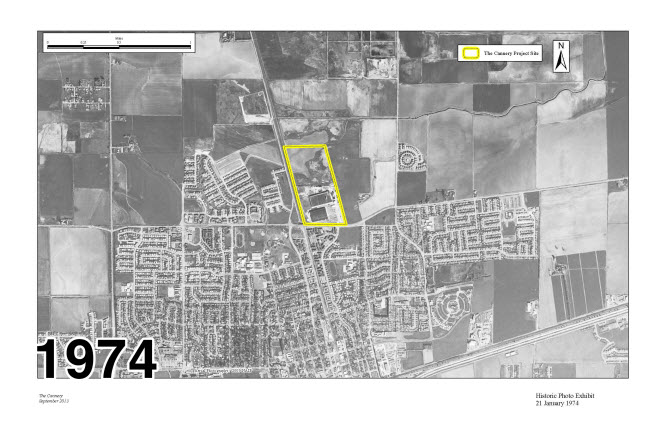

So, why do we need this project?
In the past, Rich Rifkin corrected me with regard to the actual growth of Davis over time since I first arrived in
1979 in terms of population growth. That growth did not seem “slow” to me then when presented with only numbers. This pictorial display makes that point better than I ever could in words. All of this growth has occurred within my lifetime. Seems very fast to me.
This the last report I could find.
Residential Development Status Report For Calendar Year 2011
[url]http://city-council.cityofdavis.org/media/default/documents/pdf/citycouncil/councilmeetings/agendas/20120501/packet/06i-residential-development-status-report-cy-2011.pdf[/url]
Here is a graph showing growth rates of Davis, Woodland, and West Sacramento since 1980:
[img]http://davismerchants.org/vanguard/growthratesDavisWdldWestSacsm.jpg[/img]
[url]http://davismerchants.org/vanguard/growthratesDavisWdldWestSacsm.jpg[/url]
A factor in the Davis housing market that should be noted is the October 15 decision by the Woodland city council to allow a 2.5% growth rate for Woodland over the next 20 years.
[quote]On October 15, 2013, the Woodland City Council voted to allow the addition of 10,000 more houses and apartments over the next 20 years. Woodland currently has approximately 20,000 housing units.
Ten-thousand more housing units would increase the population from ~56,000 people to ~84,000 over the next 20 years. [/quote]
“Ten-thousand more housing units would increase the population from ~56,000 people to ~84,000 over the next 20 years.”
County Rd 102 may need to go to 4 lanes.
I would love to see the maps between 1974 and 2012.
My thanks to Stephen Souza for some interesting reading. I especially found interesting the “Growth without Growth” article with its consideration of the pros and cons of population growth.
I found this especially interesting when juxtaposed with today’s Op-Ed by Debbie Nichols Poulos which highlights concerns about a perceived mismatch between the Cannery’s proposed forms of housing and the actual housing needs of the community. Rapidly approaching senior status myself, I empathize with her concerns about mobility and access limitations. This will not affect me personally as I have already downsized to precisely the kind of approx. 1500 square feet single story home she describes. However, it is very likely to impact one of the fastest growing segments of our population. For this, and safety reasons that I have put forth previously, I would again ask our city council members to take a long look behind the glossy claims of “innovation” by the developer, both in considering the Cannery project, but also in considering each new project as it comes up for consideration. A development is not a good deal for the city if it does not address the expressed needs of the community.
“A factor in the Davis housing market that should be noted is the October 15 decision by the Woodland city council to allow a 2.5% growth rate for Woodland over the next 20 years.”
More leapfrog development for Davis with more miles driven and fewer miles bicycled than if we built more houses here and they built fewer there.
I am not a proponent of the project, I think it should be kept for business use and the zoning remain. But addressing what some are saying about senior housing, from what I have learned, that aspect is addressed in many of the units, although this is according to the developers. I guess I need more details.
Its not senior housing but will accommodate seniors. The complaints contradict each other. Some argue its too dense, others argue its not dense enough. Some want density others want one story. This is what is wrong with ballot box planning.
Mr. Toad
And so who do you think should do the planning ? The developer, the city staff or council…..the “market” ?
Should we have any planning at all in your view ?
If it accommodates seniors and their needs but is not exclusive, that versatility is a plus. Density is always an issue, but this plot should be kept for business development and it’s too bad that developers have been lead on for this long for residential potential. Don’t worry, I’m a realist, I see the writing on the wall.
dlemongello
[quote]If it accommodates seniors and their needs but is not exclusive, that versatility is a plus[/quote]
Ms. Poulos claim seemed to be that it would accommodate visits by seniors but without substantial modifications, the plans as they exist would not be feasible as living spaces for seniors or those with serious mobility limitations. I have not reviewed the final plans and so have no opinion on whether or not she is accurate.
The plans as they are now have not addressed my concerns about evacuation routes or connectivity and transportation issues. I agree with you with regard to its availability as business space but also see that as a losing battle despite the zoning and adjacent businesses which seem to coexist with the residential neighbors without undue difficulty.
B. Nice said . . .
[i]”I would love to see the maps between 1974 and 2012.”[/i]
As would I. I’d also like to see the images include the whole footprint of the City’s urbanized area. I’ve put in the request.
medwoman said . . .
[i]”My thanks to Stephen Souza for some interesting reading. I especially found interesting the “Growth without Growth” article with its consideration of the pros and cons of population growth.
[b]I found this especially interesting when juxtaposed with today’s Op-Ed by Debbie Nichols Poulos which highlights concerns about a perceived mismatch between the Cannery’s proposed forms of housing and the actual housing needs of the community. Rapidly approaching senior status myself, I empathize with her concerns about mobility and access limitations. [/b]This will not affect me personally as I have already downsized to precisely the kind of approx. 1500 square feet single story home she describes. However, it is very likely to impact one of the fastest growing segments of our population. For this, and safety reasons that I have put forth previously, I would again ask our city council members to take a long look behind the glossy claims of “innovation” by the developer, both in considering the Cannery project, but also in considering each new project as it comes up for consideration. A development is not a good deal for the city if it does not address the expressed needs of the community.”[/i]
Regarding medwoman’s and Debbie Nichols Poulos’ bolded words, I wonder if there isn’t a solution available to us all. Specifically, have the developers of each lot in each development (not just Cannery) establish the default configuration and default price for each and every lot they sell. So lets say that the default configuration and default price for a particular hypothetical lot is 2,200 square feet in two stories and a $400,000 sale price. Alternative configurations would be available at the buyer’s option, but the price of $400,000 would not change. Thus if Debbie or medwoman want to have a one-story 1,500 square foot house and are willing to pay $400,000 for it, then they can have it.
Thoughts?
dlemongello said . . .
[i]”I am not a proponent of the project, I think it should be kept for business use and the zoning remain. But addressing what some are saying about senior housing, from what I have learned, that aspect is addressed in many of the units, although this is according to the developers. I guess I need more details.”[/i]
Donna, if you go to the 04:18:00 point in the video of Tuesday’s Council at [url]http://davis.granicus.com/MediaPlayer.php?view_id=2&clip_id=43[/url] you will find the six minute presentation by Erin Clay-Scherer, of Eskaton’s Livable Design Division that confirms that what you have learned is correct.
[quote]As would I. I’d also like to see the images include the whole footprint of the City’s urbanized area. I’ve put in the request.[/quote]
Me too, our neighborhood is right on the edge of the map. It would be cool to see when it’s surrounding area was developed. This pictures remind me of another recurring dream of mine, that I can go back in time and visit Davis at various points in history to to see how things have changed.
“And so who do you think should do the planning ? The developer, the city staff or council…..the “market” ? “
The City Council should direct the staff to work with the developers to come up with a plan that meets Council goals. The City Council should make the determination by majority vote. otherwise you get these competing demands with one group or another always threatening with trying to kill a project. Its impossible to get anything done the way things are currently structured where we vote on everything and developers are left spinning trying to be everything to everyone.
Mr. Toad
I would see that as an acceptable model as long as the City Council were working with in the parameters of a General Plan developed by an open an transparent process with public input throughout its design.
medwoman, your comment confuses me. Are you saying that the Davis General Plan was not developed by an open an transparent process with public input throughout its design?